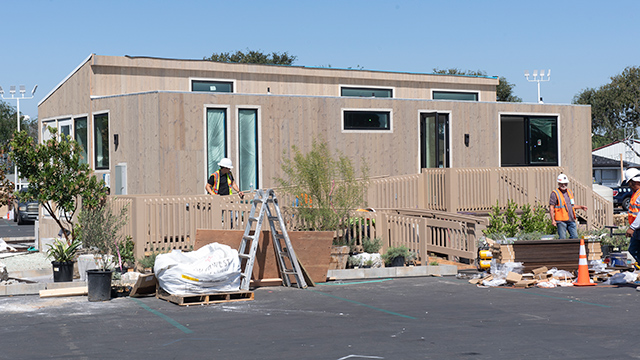Roots House, a market-ready and energy-efficient family home designed and built by a team of Cal Poly Pomona students, won 10 awards including a Top 3 spot in the inaugural Orange County Sustainability Decathlon (OCSD).
The state-funded juried competition is modeled after the U.S. Department of Solar Energy's Solar Decathlon and challenged 14 collegiate teams from far away as China to design and build solar-powered homes - a real-world exercise themed around two of California's intersecting policy priorities: climate change and affordable housing.
The 1,008-square-foot Roots House's first full assembly and completion took place at the Orange County Fair and Event Center days leading up to the competition on Oct. 5-15. The Cal Poly Pomona team won the No. 3 spot overall and was recognized in the following categories:
1st Place:
- Communications & Marketing
- Health & Comfort (tied with Rancho Cielo Youth Campus)
- Energy Efficiency (tied with CSU Northridge, CSU Long Beach, Rancho Cielo Youth Campus, UC Irvine Engineering, UC Irvine/Orange Coast College, UC San Diego/Zhejiang Normal University, and UC Santa Cruz)
2nd Place:
- Architecture & Interior Design
- Lighting & Appliances
3rd Place:
- Market Potential
- Water Use & Conservation
- Sustainability & Resilience
- Engineering & Construction (tied with CSU Long Beach)
The house is the culmination of three semesters' work by more than 100 students from across nine majors - civil, chemical, environmental, mechanical, electrical and computer engineering; architecture; regenerative studies; and business administration.
"I'm incredibly proud of our students who have shown tremendous growth through this project and held on to the vision of the Roots House and Community to see it come to life," said Civil Engineering Assistant Professor Sunai Kim, lead faculty advisor. "Our students are incredibly smart, resourceful, persistent, and hard-working."
The house is currently seeking a buyer. Kim envisions two options for the future: (1) bringing the Roots House to market in five to 10 years for use as an accessory dwelling unit (ADU), also known as a backyard cottage or granny flat; and (2) developing the Roots Community to foster climate-resilient multigenerational neighborhoods.
The Roots House's notable features include:
- Energy Efficiency: Passive cooling and natural ventilation, natural lighting with clerestory windows, white cool roof with a high Solar Reflectance Index to keep the house naturally cool, ENERGYSTAR appliances, mini split system to reduce energy costs, high-performance solar panels and battery, and a fast-charging EV Charger.
- Water Efficiency: Greywater system (recycles water from shower, bath sink and clothes washer for toilet flushing and irrigation), rain barrels, low-flow water conservation fixtures, and a fog collection - a key engineering feature for water conservation.
- Materials: Chosen for their low embodied energy (a key factor to assess the sustainability of a construction material or product), low maintenance and sustainable materials. Chemical-free materials (Living Building Challenge's Red List) were selected for the flooring and countertops.
The project's mission and multidisciplinary approach resonated with student team members like third-year regenerative studies graduate student Priyankaa Cid, who felt that it aligned with the core tenets in her field of study: "It involves a holistic systems approach and design."
"I appreciate the consideration of embodied carbon in the materials used to build the Roots House as well as the consideration of the material's end of life cycle," she said. "I'm most impressed by the use of 100% hemp insulation, highlighting the significance of prioritizing less conventional yet sustainable building materials often overlooked in construction. These substitutions and considerations become part of a larger network of environmentally conscious decisions that contribute to total systems change."
For architecture senior Kevin Chimpen, getting involved was borne from a personal interest in the climate crisis and housing insecurity, and the architecture profession's role in addressing both issues.
"These are primary concerns for architects," Chimpen said. "Our aim is to create conscientious architecture that mitigates existing negative effects. Our values and sense of social responsibility drive our commitment to benefit our community."
A large part of the funds to build and the sustainable construction materials were received through in-kind donations by nearly 50 sponsors, including Chino-based AMCO Structures for construction.
"Hundreds of students, faculty members, countless sponsors and advisors have worked together to make this project a reality," said Architecture Professor Juintow Lin, a faculty advisor. "Never have I witnessed such teamwork and passion from so many interdisciplinary individuals in such a short amount of time."
 Sustainability Decathalon house Sustainability Decathalon house-Students and workers put the final touches on the Cal Poly Pomona entry to the Sustainability Decathalon at the Orange County Fairgrounds October 3, 2023.
Sustainability Decathalon house Sustainability Decathalon house-Students and workers put the final touches on the Cal Poly Pomona entry to the Sustainability Decathalon at the Orange County Fairgrounds October 3, 2023.




